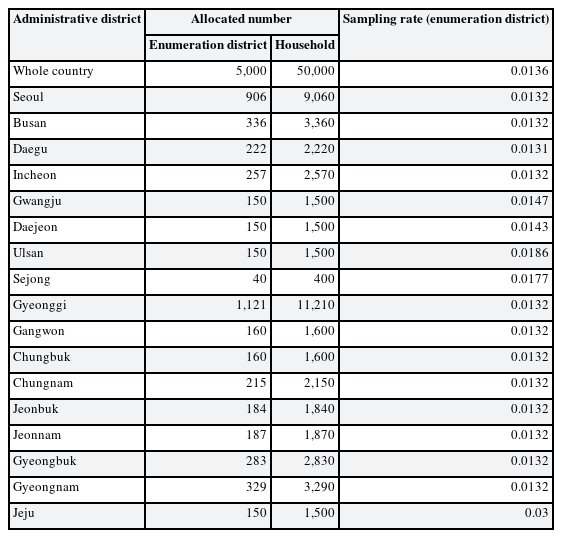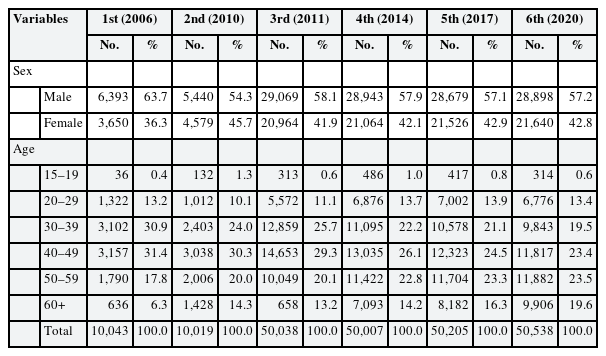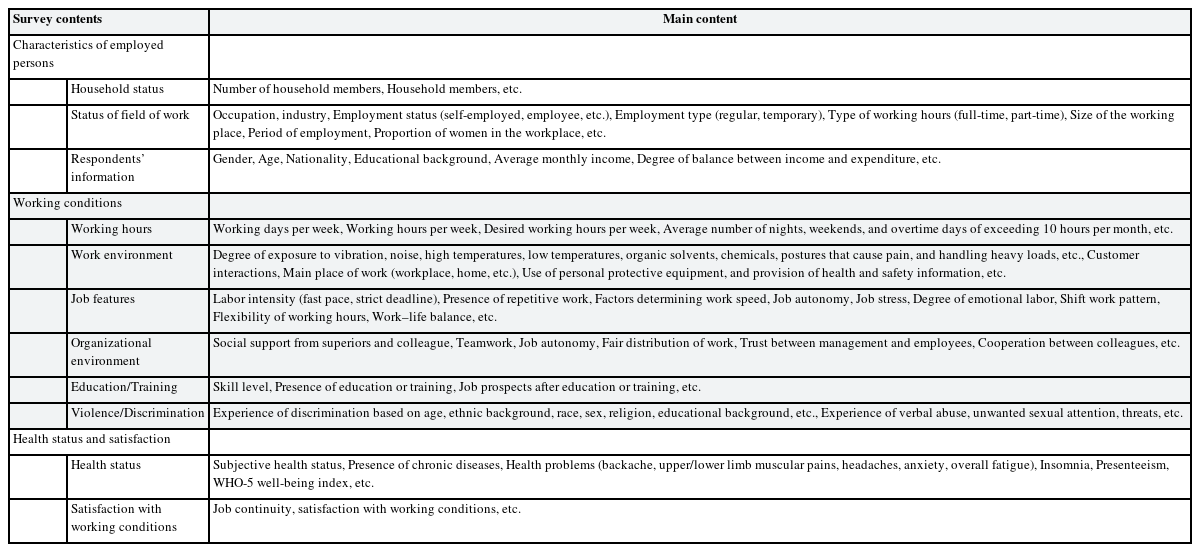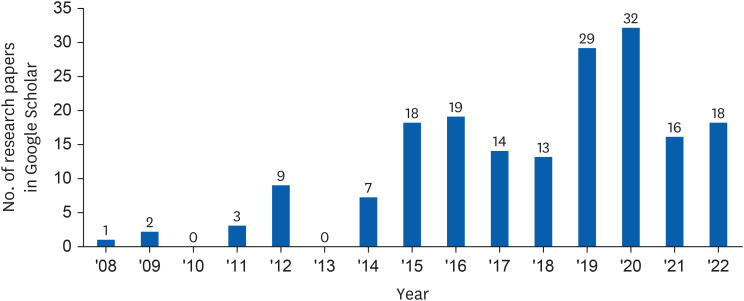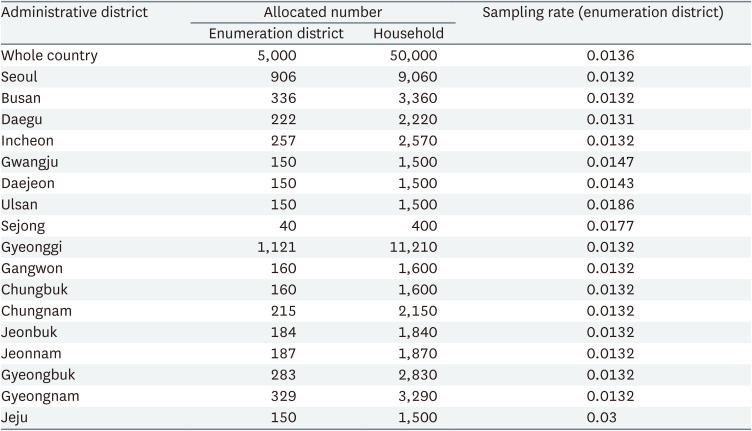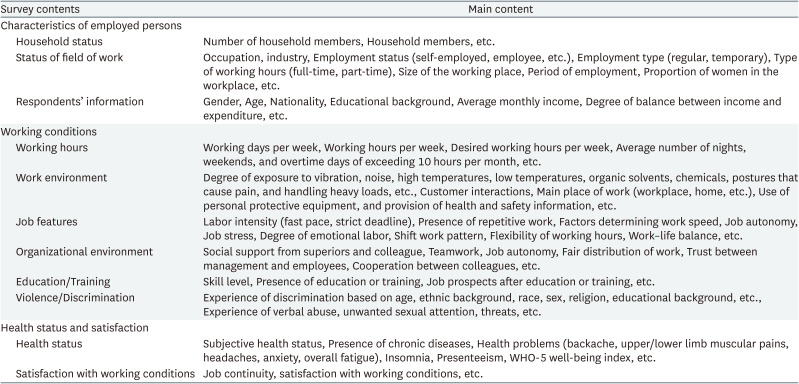Data resource profile: the Korean Working Conditions Survey (KWCS)
Article information
Abstract
The Korean Working Conditions Survey (KWCS) is a state-approved statistical survey that has been conducted by the Occupational Safety and Health Research Institute (OSHRI) every 3 years since 2006 to monitor changes in the working conditions of Koreans. This cross-sectional national survey involves a sample of 50,000 employed people aged 15 or older. KWCS measures various working conditions through > 130 survey questions, including questions regarding working hours, labor intensity, work–life balance, degree of exposure to risk factors, and subjective health status. Professional survey interviewers visit households and conduct face to face interviews. KWCS provides data and statistics for occupational safety and health polices and research in Korea. Furthermore, OSHRI holds academic conferences every year, awards high-quality academic papers, and supports researchers using data. Microdata is publicly available through the OSHRI website (https://oshri.kosha.or.kr).
BACKGROUND
The Korean Working Conditions Survey (KWCS) is a cross-sectional survey used to monitors the various working conditions affecting Koreans’ occupational safety and health for employed persons aged 15 and older, including the self-employed individuals, living throughout the Republic of Korea. It aims to collect data for occupational safety and health policies and research. The survey’s main objectives are to measure the working conditions in Korea, analyze relationships between different aspects of working conditions, identify groups at risk, and monitor trends over time.
In Korea, the industrial incidence rate, which is the number of workers who suffer an occupational injury or disease per 100 workers in a year, has been continuously decreasing, from 4% in the 1970s to < 1% since 1995; however, since 2003, occupational diseases caused by the working conditions, such as musculoskeletal disorders, have emerged as a social problem.1 Thus, there is an increased need for data on employees’ complex working conditions such as psychosocial factors, ergonomic factors, and work–life balance, in addition to mechanical, physical, and chemical risk factors. In response, the Occupational Safety and Health Research Institute (OSHRI), an organization affiliated with the Ministry of Employment and Labor, launched the first KWCS in 2006 by benchmarking the European Working Conditions Survey (EWCS) of the European Foundation for the Improvement of Living and Working Conditions (Eurofound), an agency of the European Union.2 KWCS is currently conducted every 3 years and six surveys have been completed so far. The seventh survey is underway in 2023. The survey is conducted by trained interviewers who visit households and conduct face-to-face interviews with one employed person per household. In addition, KWCS has been approved by Statistics Korea since the first survey, ensuring the reliability of the data.
Ethics statement
KWCS is a government-approved statistical survey that is not subject to Institutional Review Board review because its primary purpose is to create administrative data, not research data.
DATA RESOURCE AREA AND POPULATION COVERAGE
The target population of KWCS is employed persons aged 15 years or older residing in Korea. The survey population comprises employed persons aged 15 years or older living in households in the apartment and general survey districts, using the data of The Population and Housing Census, a national household survey conducted by Statistics Korea, as the sampling frame. KWCS defines “employed person” as a person who has worked for at least 1 hour for income in the past week at the time of the survey.
The KWCS sample is designed using secondary probability proportion-stratified cluster sample surveys. The primary sampling unit considered from the sample distribution applicable as a survey unit is the enumeration district, the second sampling unit is the household, and the final sampling unit is the working household members.
The sample design first stratifies and allocates samples (survey districts), stratifying the country into 17 metropolitan administrative regions, and then divides the provinces into sub-regional units. For a sample size of 50,000 people, 10 households per survey district are surveyed in 5,000 survey districts. To ensure that the sample sizes of each of the 17 provinces can produce statistics with precision, 150 survey districts are allocated at first; remaining survey districts are then proportionally allocated based on the size of the survey districts and the type of housing in each region. And in the case of Sejong City, 40 survey districts are prioritized to ensure a minimum valid sample. The results of the survey district allocation for the third KWCS in 2020 are shown in Table 1.3
A sample of 10 households is extracted from each survey district using systematic sampling. The survey unit is one person per household. A professional survey interviewer identifies eligible respondents after evaluating the list of household members. If there are two or more eligible respondents, one is randomly selected by Tablet PC-Assisted Personal Interviewing. The limit of maximum permission error for the estimation of population proportion was approximately 0.5%p at a 95% confidence level.4
Weighted values for KWCS were obtained through an adjustment step using design weights and information on the population. The design weight was calculated as the reciprocal of the household sampling rate by stratum. Weight adjustment, using population information, matches the population and sample structures and increases the accuracy of estimation. Using the results of Korea’s representative employment statistics survey, the “Economically Active Population Survey” conducted by Statistics Korea as auxiliary information for the population, the weights are adjusted by applying the raking ratio method for the number of employed persons by gender, age group, industry classification, and employment status.3
The number of respondents is shown in Table 2.
SURVEY FREQUENCY AND RESPONSE RATE
KWCS conducted its first survey in 2006 and then in 2010, 2011, 2014, 2017, and 2020. The sixth survey has been completed, followed by the seventh survey in 2023. When the first survey was conducted in 2006, the survey cycle was planned to be conducted every 4 years with a sample size of 10,000; however, after the second survey in 2010, the cycle was shortened to 1 year because the results were deemed to be highly useful. As the need for microlevel research on various groups considering occupation and industry increased, the sample size has been enlarged to 50,000 since the third survey in 2011, while a 3-year cycle was deemed appropriate for identifying trends in the working conditions due to the burden on the budget, so it was changed to a 3-year cycle, and to date, the survey has been conducted on a 3-year cycle for 50,000 people. The fieldwork period takes approximately 3–4 months, beginning in June or July of the year and completed in October or November. However, for the sixth survey in October 2020, due to the coronavirus disease 2019 (COVID-19) pandemic, the fieldwork period took approximately 7 months to complete, including a three-month break, and ended in April 2021 (Table 3).
The response, cooperation, refusal, and contact rates of KWCS are shown in Table 4, along with the response rate of EWCS for reference.4 In the case of the sixth KWCS, the response rate was 0.349, cooperation rate was 0.598, refusal rate was 0.235, and contact rate was 0.590, which were lower than the results of the previous survey due to the COVID-19 pandemic. These rates are calculated by applying the response rate 3, cooperation rate 3, refusal rate 2, and contact rate 2 formulas recommended by the American Association for Public Opinion Research standard definitions.
MEASURES
KWCS comprised over 130 questions on employee characteristics such as gender, age, occupation, and employment status; working environment such as weekly working hour, degree of exposure to risk factors, shift work pattern; and health status and satisfaction with working conditions. The contents of KWCS are listed in Table 5.
The survey interviewer is required to pass the test after undergoing the training programs, such as role-playing practical training. To increase the possibility of contact with the respondents, the sample households were visited at least four times, varying by day (weekdays and weekends) and time (morning and afternoon). OSHRI has managed the survey and data processing processes during the survey through external expert institutions such as the Korean Statistical Society for reliable statistical quality.4
DATA RESOURCE USE
KWCS data are widely used by government organization and researchers. When the Ministry of Employment and Labor established a new law to protect emotional laborers in 2018, KWCS data provided parameter estimates of emotional workers and information on their working conditions. Furthermore, KWCS has provided supporting statistics for the establishment of the 5-year plan for Occupational Safety and Health, a mid- and long-term strategy for the protection of the safety and health of workers established by the Ministry of Employment and Labor every 5 years. KWCS data are also used for international comparative studies, for example, to describe the working conditions in Korea for the publication of “Working conditions in a global perspective,” a research report for the international development of working conditions published by the International Labour Organization and Eurofound in 2019.5
Meanwhile, a search with the keyword “KWCS” in Korean and English using Google Scholar shows that the number of studies using KWCS data has increased since 2015, when the results of the 4th KWCS were announced (Fig. 1).
Choi and Park6 analyzed 155 papers using KWCS data published in the academic journal database RISS and PubMed from January 1, 2006 to March 5, 2019, and reported that the number of papers using KWCS data was steadily increasing every year. Moreover, KWCS data were consistently used in papers dealing with traditional occupational safety and health topics, and the topics covered became more diverse every year, such as emotional labor and work–life balance (Fig. 2).
Since 2014, a contest has been held annually for papers using KWCS data to foster emerging researchers in the field of occupational safety and health and discover new research topics. The 10th KWCS paper contest was held in 2023, and the number of papers submitted in the contest has also continuously increased.
STRENGTH AND WEAKNESS
KWCS is a large-scale survey with a sample size of 50,000, representing the working conditions for all employed people in Korea, including not only employees but also self-employed people. To improve the quality of the results, continuous quality control is performed not only at the time of the survey but also after the survey. In addition, conducting the survey every 3 years makes it possible to monitor changes in the working environment over an extended period. Another advantage of KWCS is that it can be compared and analyzed with the results of surveys from European countries, as it uses the same questions as the EWCS. KWCS provides information on the industry in which the respondent is employed up to the second (2-digit) of the Korean Standard Industrial Classification, and occupation up to the third level (3-digit) of the Korean Standard Classification of Occupations. This allows for analysis of specific industries and occupations of interest.
Nevertheless, KWCS also has some limitations. Similar to other surveys, the responses are subjective, based on the respondent’s beliefs and opinions. For questions about experiences over the past 1 or 3 years, the responses are based on the respondent’s memory. Additionally, responses about health status, back pain, and headaches are based on the respondent’s subjective judgment rather than a professional medical diagnosis. From a researcher’s perspective, it is a cross-sectional survey that collects data from a new sample every 3 years; therefore, it is impossible to confirm causality when conducting research with KWCS data. Therefore, the limitations of KWCS data should be carefully considered when interpreting the results of analyses.
DATA ACCESSIBILITY
KWCS microdata and reports are available and can be downloaded for free from the website of OSHRI (Korean: http://oshri.kosha.or.kr/oshri/researchField/workingEnvironmentSurvey.do, English: http://oshri.kosha.or.kr/eoshri/resources/KWCSDownload.do). Microdata is provided with questionnaires and a data usage manual, and are available in various file formats, including SPSS, SAS, and STATA. In addition, questionnaires and microdata in English are also available. The materials in English cn be downloaded from the English website of the OSHRI. To enable more researchers around the world to use KWCS data, KWCS data will be deposited and provided in major foreign data repositories. In early 2024, KWCS data will be available through Harvard Dataverse (https://dataverse.harvard.edu/).
Acknowledgements
We are grateful to all respondents for their time and participation in Korean Working Conditions Survey (KWCS), and to all surveyors for their dedication and hard work in conducting KWCS even in challenging conditions.
Notes
Funding: Korean Working Conditions Survey is conducted with funding from the Occupational Accidents Prevention Fund of the Ministry of Employment and Labor.
Disclosure: There are no financial or other issues that might lead to conflict of interest.
Abbreviations
COVID-19
coronavirus disease 2019
Eurofound
European Foundation for the Improvement of Living and Working Conditions
EWCS
European Working Conditions Survey
KWCS
Korean Working Conditions Survey
OSHRI
Occupational Safety and Health Research Institute

